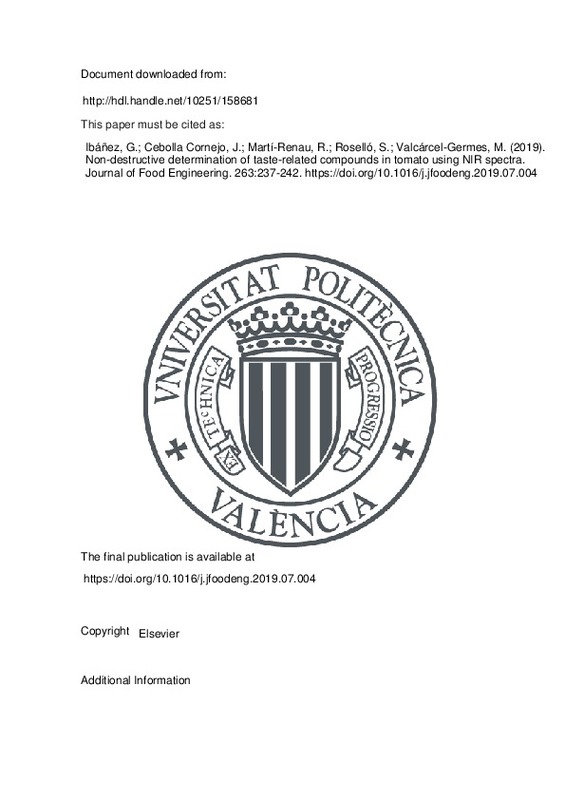JavaScript is disabled for your browser. Some features of this site may not work without it.
Buscar en RiuNet
Listar
Mi cuenta
Estadísticas
Ayuda RiuNet
Admin. UPV
Non-destructive determination of taste-related compounds in tomato using NIR spectra
Mostrar el registro sencillo del ítem
Ficheros en el ítem
| dc.contributor.author | Ibáñez, Ginés
|
es_ES |
| dc.contributor.author | Cebolla Cornejo, Jaime
|
es_ES |
| dc.contributor.author | Martí-Renau, Raul
|
es_ES |
| dc.contributor.author | Roselló, Salvador
|
es_ES |
| dc.contributor.author | Valcárcel-Germes, Mercedes
|
es_ES |
| dc.date.accessioned | 2021-01-12T04:31:57Z | |
| dc.date.available | 2021-01-12T04:31:57Z | |
| dc.date.issued | 2019-12 | es_ES |
| dc.identifier.issn | 0260-8774 | es_ES |
| dc.identifier.uri | http://hdl.handle.net/10251/158681 | |
| dc.description.abstract | [EN] Near infrared (NIR) diffuse reflectance was used to predict the contents of taste-related compounds of tomato. Models were obtained for several varietal types including processing tomato, cherry and cocktail tomato, mid-sized tomato and tomato landraces, with a wide range of varieties. Good performance was obtained for the prediction of soluble solids, sugars and acids, considering a non-destructive methodology applied to fruits with different internal structure. Specific models averaged RMSEP (%mean) values lower than 6.1% for SSC, 13.3% for fructose, 14.1% for glucose, 12.7% for citric acid, 13.8% for malic acid and 21.9% for glutamic acid. The performance was dependent on varietal type. General models with a higher number of samples and variation did not improve the performance of specific models. The models obtained, either specific or general, couldn't be extrapolated to external assays and an internal calibration would be required for each assay in order to provide a reliable performance. | es_ES |
| dc.description.sponsorship | This research was performed despite the lack of direct public funding for its development and thanks to the enthusiasm of the authors. The authors thank Dr. Lahoz and Dr. Campillo for providing processing tomato samples and Dr. Moreno for providing samples from tomato landraces. G. Ibanez thanks Universitat Jaume I for funding his pre-doctoral grant (PREDOC/2015/45). | es_ES |
| dc.language | Inglés | es_ES |
| dc.publisher | Elsevier | es_ES |
| dc.relation.ispartof | Journal of Food Engineering | es_ES |
| dc.rights | Reconocimiento - No comercial - Sin obra derivada (by-nc-nd) | es_ES |
| dc.subject | Fructose | es_ES |
| dc.subject | Glucose | es_ES |
| dc.subject | Citric | es_ES |
| dc.subject | Breeding | es_ES |
| dc.subject | Solarium lycopersicum L. | es_ES |
| dc.subject.classification | GENETICA | es_ES |
| dc.title | Non-destructive determination of taste-related compounds in tomato using NIR spectra | es_ES |
| dc.type | Artículo | es_ES |
| dc.identifier.doi | 10.1016/j.jfoodeng.2019.07.004 | es_ES |
| dc.relation.projectID | info:eu-repo/grantAgreement/UJI//PREDOC%2F2015%2F45/ | es_ES |
| dc.rights.accessRights | Abierto | es_ES |
| dc.contributor.affiliation | Universitat Politècnica de València. Departamento de Biotecnología - Departament de Biotecnologia | es_ES |
| dc.contributor.affiliation | Universitat Politècnica de València. Instituto Universitario de Conservación y Mejora de la Agrodiversidad Valenciana - Institut Universitari de Conservació i Millora de l'Agrodiversitat Valenciana | es_ES |
| dc.description.bibliographicCitation | Ibáñez, G.; Cebolla Cornejo, J.; Martí-Renau, R.; Roselló, S.; Valcárcel-Germes, M. (2019). Non-destructive determination of taste-related compounds in tomato using NIR spectra. Journal of Food Engineering. 263:237-242. https://doi.org/10.1016/j.jfoodeng.2019.07.004 | es_ES |
| dc.description.accrualMethod | S | es_ES |
| dc.relation.publisherversion | https://doi.org/10.1016/j.jfoodeng.2019.07.004 | es_ES |
| dc.description.upvformatpinicio | 237 | es_ES |
| dc.description.upvformatpfin | 242 | es_ES |
| dc.type.version | info:eu-repo/semantics/publishedVersion | es_ES |
| dc.description.volume | 263 | es_ES |
| dc.relation.pasarela | S\390900 | es_ES |
| dc.contributor.funder | Universitat Jaume I | es_ES |







![[Cerrado]](/themes/UPV/images/candado.png)

